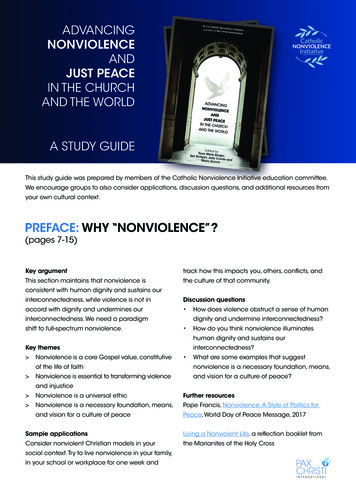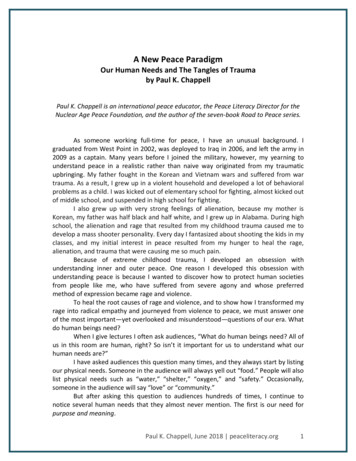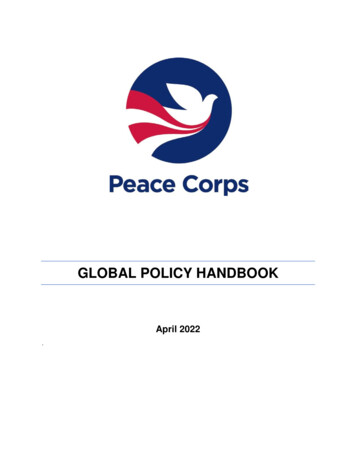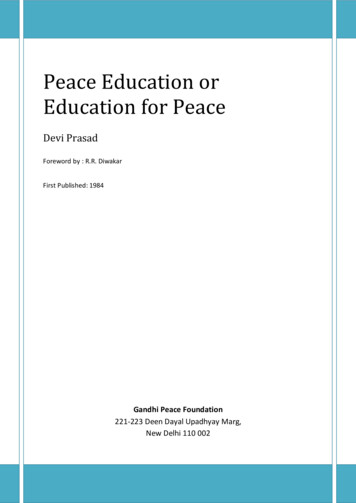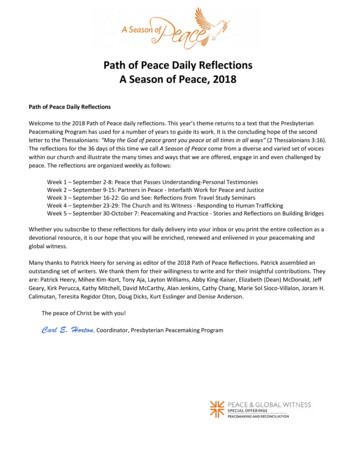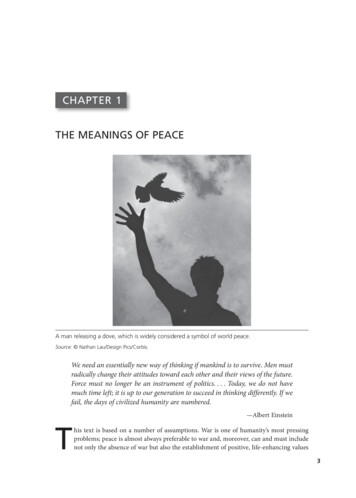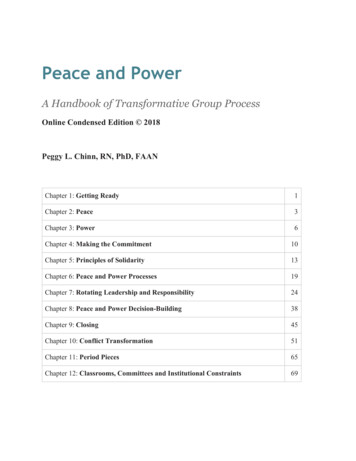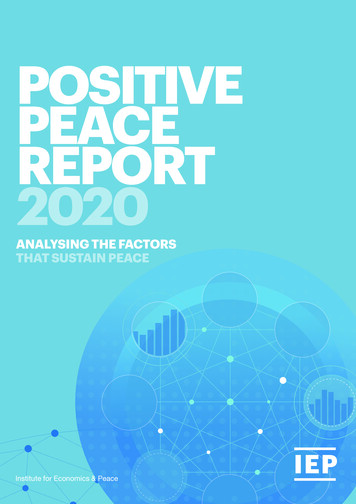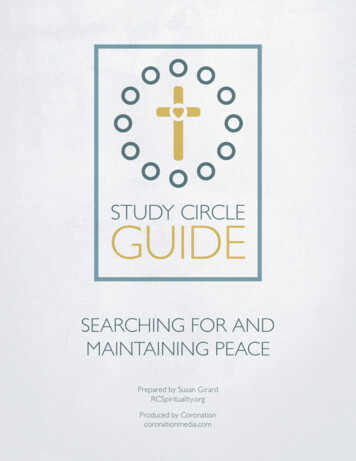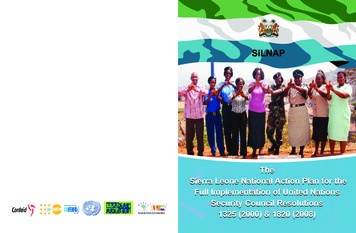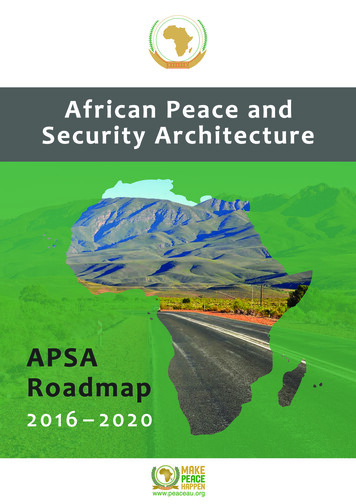
Transcription
African Peace and Security Architecture. APSA Roadmap 2016 – 2020This work is published under the sole responsibility of the African UnionCommission / Peace and Security Department. All rights reserved.You can copy, download or print the contents of this book for your own use,and you can include excerpts from this guidebook in your own documents,presentations, blogs, websites and teaching materials, provided that suitableacknowledgement of the source and copyright owner is given. All requestsfor public and commercial use and translation rights should be submitted tosituationroom@africa-union.org. African Union Commission, Peace and Security Department,Addis Ababa, December 20151st edition, December 2015African Union CommissionP.O. Box 3243Roosevelt StreetAddis Ababa, EthiopiaTel. 251 11 551 3822Fax 251 11 551 9321Email situationroom@africa-union.orgInternet: www.peaceau.orgTwitter: @AU PSDDesign Ira Olaleye, Eschborn, GermanyTitle photo PRO South African Tourism, The Karoo, Eastern Cape, South sm/205181730412
Strategic Prioritiesand IndicatorsStrategic Priority 1:Conflict PreventionStrategic Priority 2:Crisis/Conflict ManagementStrategic Priority 3:Post-Conflict Reconstructionand Peace BuildingStrategic Priority 5:Coordination andPartnershipsStrategic Priority 4:Strategic Security Issues3
African Peace and Security Architecture. APSA Roadmap 2016 – 20204
Table of ContentPreface .List of Abbreviations .Executive summary .Foreword .Introduction .APSA Legal and institutional dimensions .Progress made in implementing APSA .The APSA Roadmap 2016–2020: Strategic Priorities and Indicators .6678101214221Strategic Priority 1: Conflict Prevention .1.1Capacities of CEWS and the EWS .1.2Interaction between CEWS, regional and national EWS .1.3Engagement of CEWS/EWS with decision-makers .1.4Collaboration of CEWS/EWS with external stakeholders .1.5Capacity for structural conflict prevention . .1.6 Capacity to deploy and conduct preventive diplomacy .232325252627292Strategic Priority 2: Crisis/Conflict Management .2.1Political/legal decision-making mechanisms .2.2Capacity to plan, deploy, manage, sustain and liquidate .2.3Mission support systems and mechanisms .2.4Capacities and capabilities pledged/on standby .2.5Capacity to plan, deploy, manage, support and monitor mediation interventions . .2.6Coordination on mediation interventions . .313233343536373Strategic Priority 3: Post-Conflict Reconstruction and Peace Building .3.1PCRD Mechanisms and regional policies .3.2PCRD responds to specific needs in different conflict phases .3.3 AU and RECs coordination function of PCRD .3.4Resources for the implementation of PCRD programmes .3.5Capacities for support to post-conflict Member States . .3.6Capacities to implement the SSR policy framework .3.7Capacities of the AUC and the RECs/RMs to respond to DDR challenges .39394041424344444Strategic Priority 4: Strategic Security Issues .4.1Illicit flow of SALW .4.2Mine action and counter-IED/explosives management .4.3Weapons of Mass Destruction (WMD) disarmament and non-proliferation .4.4Counter-terrorism measures .4.5Illicit Financial Flows .4.6Africa’s Integrated Maritime Strategy (AIMS) . .4.7 AFRIPOL as coordination mechanism .46464748485052525Strategic Priority 5: Coordination and Partnerships .5.1Coordinating function of the PSC .5.2Intra- and inter-departmental collaboration/coordination . .5.3MoU between the AU and the RECs/RMs . .5.4The AU Liaison Offices .5.5Policy and strategic dialogue within APSA partnerships . .5.6Financial ownership of APSA .54545556575758Cross-cutting issues . .60Monitoring and Evaluation .61Annex .63APSA Roadmap Impact Indicators .64Results Framework Strategic Priority 1: Conflict Prevention .66Results Framework Strategic Priority 2: Crisis/Conflict Management .81Results Framework Strategic Priority 3: Post-Conflict Reconstruction and Peace Building .96Results Framework Strategic Priority 4: Strategic Security Issues . 108Results Framework Strategic Priority 5: Coordination and Partnerships . 1215
African Peace and Security Architecture. APSA Roadmap 2016 – 2020List of AbbreviationsACIRC . . African Capacity for Immediate Responseto CrisesACSRT . African Centre for Studies and Researchon TerrorismAfDB . African Development BankAFRIPOL . African Police Cooperation MechanismAIMS . Africa’s Integrated Maritime StrategyAHSG . African Heads of State and GovernmentAML/CFT . Anti-Money Laundering/Combating the Financing of TerrorismAPSA . African Peace and Security ArchitectureASC . African Standby CapacityASF . African Standby ForceASI . African Solidarity InitiativeAU . African UnionAUC . African Union CommissionAULOs . African Union Liaison OfficesC3IS . . Command, Control, Communicationand Information SystemsCAAS . Conflict Alerting and Analysis ToolsCAPCCO . Central African Police Chiefs’ CommitteeCBOs . Community Based OrganizationsCEN-SAD . . Community of Sahel-Saharan StatesCEWARN . . IGAD Early Warning SystemCEWS . Continental Early Warning SystemCISSA . . Committee of Intelligence and SecurityServices of AfricaCLB . Continental Logistics BaseCMCC . . Continental Movement Control CentresCOMESA . Common Market for Eastern andSouthern AfricaCOMWARN . COMESA Early Warning SystemConOps . Concepts of OperationsCOPAX . Council of Peace and Security inCentral AfricaCSCPF . Continental Structural ConflictPrevention FrameworkCSO . Civil Society OrganizationCSVA . Country Structural VulnerabilityAssessmentsCSVMS . Country Structural VulnerabilityMitigation StrategiesDDR . . Disarmament, Demobilization andReintegrationDDRCP . Disarmament, Demobilisation andReintegration. Capacity ProgrammeDNFBPs . Designated Non-Financial Businessesand ProfessionsDPA . Department for Political AffairsEAC . . East African CommunityEACWARN . EAC Early Warning SystemECCAS . Economic Community of Central AfricanStatesECOWAS . Economic Community of West AfricanStatesECOWARN . ECOWAS Early Warning SystemEU . European UnionEWR . . Early Warning Reports6EWS .FATF .FIU .GBV .HR .ICT . .IDTFCP .IED .IGAD .KMF .LEAs .M&E .MARAC .MoU .MSU .NEPAD . .NGOs .OAU .PCNA . .PCRD .PLANELMs .PSC .PSD . .PSO .PSP .QIPs .RDC .RECs . .RECSA .RMCC .RMs .SADC .SALW . .SARPCCO .SOP .SSR .SVA .TCC .TOC .ToR .TQM .UN .UXO .VPN .WAPCCO .WMD .Early Warning SystemsFinancial Action Task ForceFinancial Intelligence UnitGender-Based ViolenceHuman ResourcesInformation and CommunicationsTechnologyInter-Departmental Task Force onConflict PreventionImprovised Explosive DeviceIntergovernmental Authority forDevelopmentKnowledge Management FrameworkLaw Enforcement AgenciesMonitoring and EvaluationEarly Warning Mechanism on CentralAfricaMemorandum of Understanding onCooperationMediation Support UnitNew Partnership for Africa’sDevelopmentNon-Governmental OrganizationsOrganisation of African UnityPost-Conflict Needs AssessmentPost-Conflict Reconstruction andDevelopmentPlanning ElementsPeace and Security CouncilPeace and Security DepartmentPeace Support OperationsPeace Strengthening ProjectsQuick Impact ProjectsRapid Deployment CapabilityRegional Economic CommunitiesRegional Centre For Small ArmsRegional Movement Control CentresRegional MechanismsSouthern African DevelopmentCommunitySmall Arms and Light WeaponsSouthern African Regional Police ChiefsCooperationOrganisationStandard Operating ProcedureSecurity Sector ReformStructural Vulnerability AssessmentTroop Contributing CountriesTransnational Organized CrimeTerms of ReferenceTechnical Quarterly MeetingUnited NationsUnexploded OrdnanceVirtual Private NetworkWest African Police Chiefs CommitteeOrganizationWeapons of Mass Destruction
Executive summaryIn line with the Solemn Declaration on the 50th Anniversary of the Organization of African Unity/African Union of the African Heads of State and Government, that was adopted at the meetingof the AU Assembly on 25 May 2013, and in order to substantially contribute to achieving thegoals of the AU initiative on “Silencing of the Guns: Pre-requisites for realising a conflict-freeAfrica by the year 2020”, the “APSA Roadmap 2016-2020” is a strategic document, which buildson the achievements and challenges resulting from the implementation of the previous APSARoadmap (2011-2013). The Roadmap is the result of an inclusive and participatory process involving different departments at the AUC and at the RECs/RMs.The APSA Roadmap 2016-2020 provides a shared understanding of the results to be achievedby all APSA stakeholders, it articulates a shared understanding of the roles and functions eachstakeholder involved in APSA is expected to play; it highlights a shared understanding of theneed to increased collaboration and coordination among all stakeholders involved in APSA; andfinally the roadmap is the most relevant tool to communicate APSA project plans and expectedresults to Member States, partners and other external actors.With a focus on concrete activities and strategic objectives, this Roadmap aims at mapping out away forward to enable the consolidation of gains made, and address the most pressing challenges, so as to make the African Peace and Security Architecture fully functional and operational,and in this way contribute effectively to the maintenance and preservation of peace and securityin Africa.The APSA Roadmap 2016-2020 details the AUC and RECs/RMs joint aims in five strategic priorityareas: Conflict prevention (incl. early warning and preventive diplomacy), crisis/conflict management (incl. ASF and mediation), post-conflict reconstruction and peace building, strategicsecurity issues (such as illegal flows of SALW, IEDs, WMD disarmament, counter-terrorism, illicitfinancial flows as well as transnational organised crime and cyber crime) and coordination andpartnerships. In addition, cross-cutting issues are covered by the Roadmap.7
African Peace and Security Architecture. APSA Roadmap 2016 – 2020ForewordFourteen years ago, the African Union (AU) started implementing the African Peace and Security Architecture(APSA) as articulated in the 2002 Protocol Relating tothe Establishment of the Peace and Security Council(PSC) of the African Union. Since then, the Union hasmade significant progress, not only in establishing theAPSA institutions and mechanisms, but also in increasingly utilizing them for the purpose of conflict prevention, management and resolution, with a view topromoting “peace, security, and stability on the continent”, as envisaged by the 2000 Constitutive Act of theAU and in lie with the aspirations of the Africa’s people. This is all the more important given thenexus between peace, security and development. The APSA Roadmap 2016 – 2020 presentedhere manifests the continued determination to ensure further progress, and paves the way forfuture collaboration between the AU, the Regional Economic Communities (RECs) and RegionalMechanisms for Conflict Prevention, Management and Resolution (RMs) to effectively addresssecurity issues and contribute to a more peaceful Africa.The Roadmap is a strategic document, which builds on the achievements and challenges resulting from the implementation of previous APSA Roadmaps. It is based on the 2008 Memorandumof Understanding on Cooperation in the area of Peace and Security signed between the AU andthe RECs/RMs in 2008. The Roadmap is in line with the Solemn Declaration adopted by the Assembly of AU Heads of State and Government on the 50th Anniversary of the Organization ofAfrican Unity/African Union, held on 25 May 2013, in Addis Ababa, Ethiopia. It further servesto achieve the goals of the AU’s initiative on Silencing the Guns: Pre-requisites for realising aconflict-free Africa by the year 2020, in order not to bequeath the burden of conflicts to thenext generation of Africans. This Roadmap is the result of an inclusive and participatory processinvolving different Departments at the AU Commission (AUC) and at the RECs/RMs.The APSA Roadmap 2016 – 2020 provides a shared understanding of the results to be achievedby all APSA stakeholders, articulates a shared understanding of the roles and functions eachstakeholder involved in APSA is expected to perform, highlights a shared understanding of theneed for increased collaboration and coordination among all stakeholders involved in APSA, andfinally, it is the most relevant tool to communicate APSA project plans and expected results toMember States, partners and other external actors.8
With a focus on concrete activities and strategic objectives, this Roadmap aims at mapping outa way forward to enable the consolidation of gains made, and address the most pressing challenges, so as to make the APSA fully operational, and in this way contribute effectively to themaintenance and preservation of peace, security and stability in Africa. The Roadmap detailsthe joint aims of the AUC and the RECs/RMs in five strategic priority areas: Conflict prevention(including early warning and preventive diplomacy), crisis/conflict management (including theAfrican Standby Force and mediation), post-conflict reconstruction and development and peacebuilding, strategic security issues (such as proliferation of small arms and light weapons, disarmament, counter-terrorism and transnational organised crime among others), and coordinationand partnerships. In addition, cross-cutting issues – such as gender-mainstreaming in peace andsecurity and climate change – are addressed by this Roadmap.Building on the conclusions of the workshop of the AU-RECs/RMs senior officials and experts heldon 19 – 21 November 2013 in Abuja, Nigeria, the 10th meeting of AU-RECs/RMs senior officialsheld on 20 – 21 November 2014 in Cairo, Egypt, as well as the outcome of the 8th PSC Retreaton enhancement of cooperation between the PSC and the RECs/RMs held on 14 – 16 September 2015 in Abuja, Nigeria, the AU and RECs/RMs senior officials finalised this APSA Roadmap2016 – 2020 at their 11th meeting held on 23 – 25 November 2015 in Harare, Zimbabwe.The APSA Roadmap 2016 – 2010 consists of an introduction, followed by a section that recallsits legal and institutional dimension and a brief review of APSA implementation and progressmade so far. In the main part of the Roadmap, APSA strategic priorities and related indicators aredetailed. The Roadmap then concludes with brief observations on monitoring and evaluation. Adetailed results framework for the various strategic priorities is annexed to the Roadmap.Making the APSA fully operational through implementing this Roadmap, will further contributeto the capacitation of the AU and the RECs/RMs to effectively address the scourge of conflictsand crises in the continent, and promote lasting peace, security and stability in Africa.Ambassador Smaïl CherguiAU Commissioner for Peace and Security9
African Peace and Security Architecture. APSA Roadmap 2016 – 2020IntroductionAt the meeting of the African Union Assembly on 25 May 2013, African Heads of State and Government (AHSG) adopted a Solemn Declaration on the 50th Anniversary of the Organization ofAfrican Unity/African Union (OAU/AU). In this landmark declaration, the Assembly expressed itsdetermination to achieve the goal of a conflict free Africa, to make peace a reality for all peopleand rid the continent of civil wars, civil conflicts, human rights violations, humanitarian disastersand violent conflicts, and to prevent genocide. The African leaders also pledged not to bequeaththe burden of conflicts to the next generation of Africans and undertook to end all wars on thecontinent by 2020, a commitment that has taken practical expression in the AU initiative on “Silencing of the Guns: Pre-requisites for realising a conflict-free Africa by the year 2020”.As a key component of Agenda 2063, “Silencing the Guns by 2020” underlines the necessity ofmaking the continent’s mechanisms for conflict prevention, management and resolution operational at all levels – at the heart of which is a fully functional and operational African Peaceand Security Architecture (APSA). Following the recommendations of the APSA Roadmap 20112013, priority has been given to pushing ahead with the operationalization of all pillars of APSA,including those tasked with conflict prevention, peacemaking, peacekeeping and peace supportoperations, national reconciliation and post-conflict reconstruction and development. These arein line with the Strategic Plan of the African Union Commission 2014-2017 (AUC), which positsthat “the overall goal of achieving an integrated, prosperous and inclusive Africa at peace with itself playing a dynamic role on the continent and global arena cannot be realized if durable peaceand stability is not established”. In addition, improved harmonisation, collaboration and coordination between the AU and the Regional Economic Communities (RECs) and Regional Mechanisms for Conflict Prevention, Management and Resolution (RMs) in the full operationalizationof APSA remains a key strategic and operational priority.The development and implementation of the APSA Roadmap 2016-2020 is guided by the following principles:zzzzzzzzzzzzThe Roadmap is informed and driven by the spirit of collective security and self-reliance.The overarching goals and aspirations of the Roadmap are anchored in, and contribute towards achieving the objectives of “Silencing the Guns by 2020” and the first 10-Year Implementation Plan of the Union’s “Agenda 2063”.The Roadmap aims at strengthening ownership, consensus and synergy between the AU andthe RECs/RMs.Sustainability is at the heart of the APSA Roadmap.The Roadmap is results-oriented.The AU maintains a leadership role in the implementation of the APSA Roadmap 2016-2020.The “APSA Roadmap 2016-2020” is a strategic document, which builds on the achievements andchallenges resulting from the implementation of the previous APSA Roadmap (2011-2013). Thisdraft Roadmap aims at mapping out a way forward to enable the consolidation of gains made,and address the most pressing challenges, so as to make APSA fully functional and operational,and in this way contribute effectively to the maintenance and preservation of peace and securityin Africa.10
This Roadmap is the result of an inclusive and participatory process involving different departments at the AUC and at the RECs/RMs. It fulfils five major functions, which might be summarized as follows:zzFirst, it provides a shared understanding of the results to be achieved by all APSA stakeholders. The AUC and the RECs/RMs have collectively developed the roadmap and its resultsframeworks, and this document reflects a collective agreement on the strategic priorities andon the objectives that need to be reached during the period 2016-2020.zzSecond, the roadmap articulates a shared understanding of the roles and functions eachstakeholder involved in APSA is expected to play. APSA is intended to effectively deal with awide range of issues, conflicts and crises, whose nature, intensity and geographical scale varygreatly and require specific and adapted responses. The clarification, common understandingof and the respect for the complementarity between the roles and functions of each stakeholder is crucial to the effective implementation of APSA.zzThird, the roadmap highlights a shared understanding of the need to increased collaborationand coordination among all stakeholders involved in APSA. Not only does APSA deal with awide range of issues, but it also involves a wide range of stakeholders, of organisations withtheir own history, mandate, priorities and competences. Bringing all these stakeholders towork in a coordinated manner is a key condition to increase the probability that the expectedresults might be achieved.zzFinally, the roadmap is the most relevant tool to communicate APSA project plans and expected results to Member States, partners and other external actors. APSA is, indeed, supportedby a large number of technical and financial partners. Moreover, APSA is of great interest forMember States and a multitude of actors (other continental bodies, academia, etc.). Havinga single communication tool is of utmost importance for clarity and transparency purposesand guide interventions on the continent.11
African Peace and Security Architecture. APSA Roadmap 2016 – 2020APSA Legal and institutional dimensionsAt the heart of APSA are the 2000 Constitutive Act of the African Union and the 2002 ProtocolRelating to the Establishment of the Peace and Security Council (PSC). APSA aims to outline thesystem (roles, instruments and procedures) by which the AU, the RECs as well as the RMs canrealise their conflict prevention, management and resolution mandates. The APSA, as enshrinedin the PSC Protocol, embraces an expanded and comprehensive agenda for peace and securitythat includes (direct and structural) conflict prevention, early warning and preventive diplomacy,peace-making and peace building, the encouragement and promotion of democratic practicesas well as intervention and humanitarian action and disaster management.Before the transition of the Organization of African Unity (OAU) to the African Union, an OAUMechanism for Conflict Prevention, Management and Resolution existed (it was established July1993 in Cairo), to provide the Organization with instruments capable of enabling it to deal withthe scourge of conflicts and to facilitate collective African action in matters of conflict management. However, the scope and gravity of the conflicts, as well as their complex nature, soonrevealed the limitations of the Mechanism, which among other things, was not equipped withthe means for the deployment of peace keeping operations, a responsibility left exclusively tothe United Nations (UN).The AU recognizes eight
agement (incl. ASF and mediation), post-conflict reconstruction and peace building, strategic security issues (such as illegal flows of SALW, IEDs, WMD disarmament, counter-terrorism, illicit financial flows as well as transnational organised crime and cyber crime) and coordination and partnerships.
